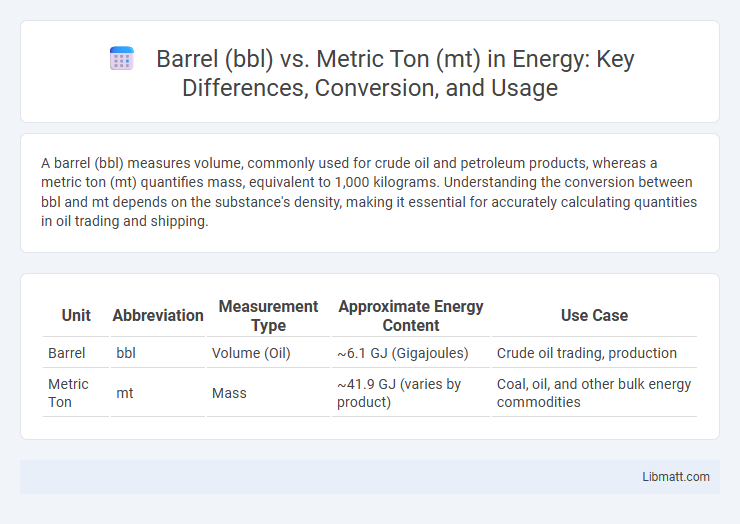A barrel (bbl) measures volume, commonly used for crude oil and petroleum products, whereas a metric ton (mt) quantifies mass, equivalent to 1,000 kilograms. Understanding the conversion between bbl and mt depends on the substance's density, making it essential for accurately calculating quantities in oil trading and shipping.
Table of Comparison
| Unit | Abbreviation | Measurement Type | Approximate Energy Content | Use Case |
|---|---|---|---|---|
| Barrel | bbl | Volume (Oil) | ~6.1 GJ (Gigajoules) | Crude oil trading, production |
| Metric Ton | mt | Mass | ~41.9 GJ (varies by product) | Coal, oil, and other bulk energy commodities |
Introduction to Barrel (bbl) and Metric Ton (mt)
A Barrel (bbl) is a volume measurement commonly used in the oil industry, equivalent to 42 US gallons or approximately 159 liters. A Metric Ton (mt) measures weight, specifically 1,000 kilograms or about 2,204.62 pounds, often employed in shipping and commodity trading to quantify mass. Understanding the distinction between bbl and mt is essential for accurately interpreting oil and other bulk material quantities in your operations.
Definition and Origins of Barrel (bbl)
The barrel (bbl) is a unit of volume traditionally used in the oil industry, defined as 42 US gallons or approximately 159 liters. The term originated in the early 19th century with American oil producers standardizing the size to facilitate trade and measurement consistency. The abbreviation "bbl" is believed to stem from "blue barrel," referencing the blue-painted barrels used by Standard Oil for crude oil storage.
Understanding the Metric Ton (mt)
A metric ton (mt) is a unit of mass equal to 1,000 kilograms or approximately 2,204.62 pounds, widely used in global trade and industry for measuring bulk materials like oil, coal, and metals. Unlike the barrel (bbl), which measures volume specifically in the petroleum sector (one barrel equals 42 US gallons or about 159 liters), the metric ton focuses on weight, providing a standardized metric for comparing mass across different substances. Conversion between metric tons and barrels depends on the density or specific gravity of the material, making understanding the metric ton essential for accurate calculations in logistics and trading.
Key Differences Between bbl and mt
Barrel (bbl) and Metric Ton (mt) are distinct units used in measuring volume and mass, respectively, in the oil and chemical industries. A barrel quantifies liquid volumes, commonly 42 US gallons or approximately 159 liters, while a metric ton measures weight, equivalent to 1,000 kilograms. Conversion between bbl and mt depends on the substance's density, making it critical for precise inventory, trading, and transportation calculations.
Industry Usage: When to Use bbl vs mt
Barrel (bbl) is primarily used in the oil and petroleum industry to measure crude oil and liquid hydrocarbons, providing volume-based quantification essential for trading and inventory. Metric Ton (mt) is favored in industries dealing with bulk solids, chemicals, and refined petroleum products where weight measurement is critical for transport and pricing accuracy. Your choice between bbl and mt depends on whether volume or weight better suits the operational and commercial requirements of your specific industry application.
Conversion Factors: bbl to mt and Vice Versa
One barrel (bbl) of crude oil typically equals about 0.136 metric tons (mt), though this conversion varies with the oil's specific gravity and density. To convert from metric tons to barrels, you divide the quantity in metric tons by the factor representing weight per barrel, often around 7.33 bbl per mt for average crude oil. Understanding these conversion factors helps you accurately compare volumes and weights across different measurement systems in the energy industry.
Implications for Oil and Gas Trade
Barrel (bbl) and Metric Ton (mt) are key units in oil and gas trade, affecting volume-to-weight conversions crucial for pricing and logistics. Variations in crude oil density lead to conversion factors typically ranging from 6.6 to 8.1 barrels per metric ton, influencing international trade contracts and inventory management. Accurate conversion ensures transparency in shipment specifications, cost calculations, and compliance with global trade standards.
Impact on Pricing and Market Reporting
The difference between Barrel (bbl) and Metric Ton (mt) significantly impacts pricing and market reporting in the oil industry, as barrels measure volume while metric tons measure weight, leading to variations based on crude oil density or API gravity. Pricing indexed by barrels often reflects a volume-based market standard prevalent in the US, whereas metric tons are favored in regions like Europe and Asia, influencing contract terms and price benchmarks. Market reports must accurately convert between bbl and mt using region-specific conversion factors to ensure price transparency and consistency in global trade analysis.
Common Pitfalls and Misconceptions
Confusing barrels (bbl) and metric tons (mt) often arises from neglecting the variable density of crude oil, which affects volume-to-weight conversions. Assuming a fixed conversion rate between barrels and metric tons leads to inaccurate calculations due to differences in API gravity and temperature. Accurate measurement requires specifying the crude grade and applying precise density data rather than using generalized conversion factors.
Choosing the Right Unit: Best Practices
Choosing the right unit between barrel (bbl) and metric ton (mt) depends on the substance being measured and the industry standards. Barrels are typically used for volume measurement in the oil and petroleum sectors, while metric tons measure mass and are preferred when density and weight are crucial. To optimize accuracy in your calculations and reporting, always consider the product type, regional regulations, and conversion factors specific to your application.
Barrel (bbl) vs Metric Ton (mt) Infographic

 libmatt.com
libmatt.com